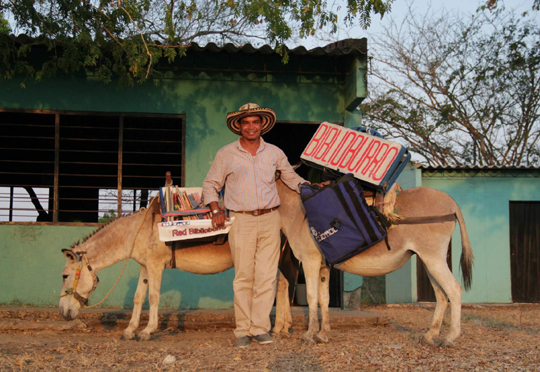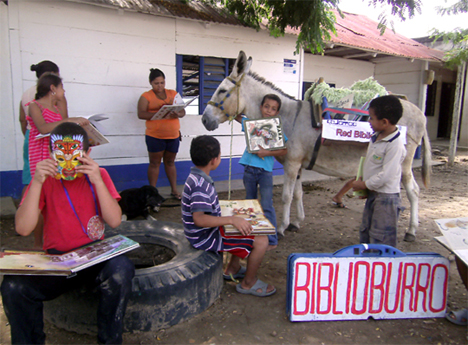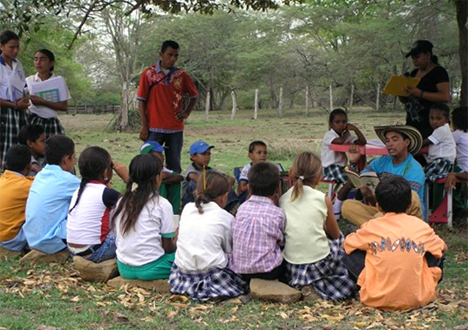 In the early hours of the morning, long before the sun rises, primary school teacher Luis Soriano Bohorque selects books, loads them on his two donkeys, and journeys to remote villages in Colombia. His mission is to bring books and educational programs to over 300 rural children, many of whom have no access to reading materials. The program is called Biblioburro, and Luis has been operating it for over 14 years.
In the early hours of the morning, long before the sun rises, primary school teacher Luis Soriano Bohorque selects books, loads them on his two donkeys, and journeys to remote villages in Colombia. His mission is to bring books and educational programs to over 300 rural children, many of whom have no access to reading materials. The program is called Biblioburro, and Luis has been operating it for over 14 years.
I got in touch with Luis after reading the splendid picture book Biblioburro: A True Story from Colombia by Jeanette Winter (Beach Lane Books, 2010). Our interview has been translated from Spanish to English (you can read the original Spanish version here).
We are grateful to Paloma Moscardó-Valles from Princeton University’s Spanish and Portuguese Languages and Cultures department for her translation work. ¡Muchas gracias Paloma!
You began this program in 1990. How did you come up with the idea for Biblioburro?
This idea was born in 1997. My community was in need of many things: there were no schools, nor teachers, the children couldn’t go to school, many of them worked. This is how I started this adventure with Alfa and Beto (my two donkeys) that we called BIBLIOBURRO (Donkey Library). Today it is a great blessing for more than 300 children of many communities in the department of Magdalena in Colombia.
 Describe a typical work day with this program.
Describe a typical work day with this program.
A typical BIBLIOBURRO day starts at 3:00 a.m.: I choose the books and I start the journey. It can take up to 2 to 6 hours including the trip, getting the kids together, and starting the literacy and learning work. I return home before 5:00 p.m.
Please tell us about the children you visit.
The children that I visit live in a vulnerable situation, with few economic resources, many of them don’t have parents because they were killed in the Colombian Conflict some years ago. These children are full of dreams and hope and they want to move forward.
 Can you name a few of your favorite books from childhood?
Can you name a few of your favorite books from childhood?
Margarita de Baile (Margarita of Dancing), Cuentos y Aventuras para Niños (Stories and Adventures for Kids), Rin Rin Renacuajo ( Rin Rin Tadpole), among others.
How many books do you currently have in your library, and what kinds of books do you have?
Nowadays there are 6,000 books – stories, novels, fables, contemporary literature, encyclopedias, dictionaries.
What are some of the most popular titles with your patrons?
The most popular books are children stories, encyclopedias to search about important topics, and reference books.
What is one of your greatest hardships?
The biggest difficulty is not having resources for this task. We put great effort and sacrifice into our work. We need to repair the Library, to buy new equipment for the Biblioburro Digital, and I need a new prosthesis for my leg [Editor: Luis lost a leg in a traffic accident, but continued the program].
 Could you tell us a little more about the Biblioburro Digital?
Could you tell us a little more about the Biblioburro Digital?
Biblioburro Digital is a program of learning reinforcement through computer and virtual educative programs. Books are still important for us. Biblioburro Digital has another program called “Countryside Movies” which are movie days for kids. It’s a very special moment to share. We have 5 computers and a projector. We urgently need a television for our library, and a new projector. We put in a lot of effort and dedication.
What are your plans for the program’s future?
In the future we’d like to have a Digital Library, better work tools, and more educational materials to strengthen the program.
What part of your work brings you the most joy and satisfaction?
All of my work gives me joy and satisfaction, seeing the kids happy when I arrive with my two donkeys is priceless. I love my job despite all the adversities and problems, and I always have a good disposition and attitude when facing the circumstances.
If you’d like to learn more about Luis and his program, you can visit the Biblioburro FaceBook page. All images are used with permission of Luis Soriano Bohorque.

